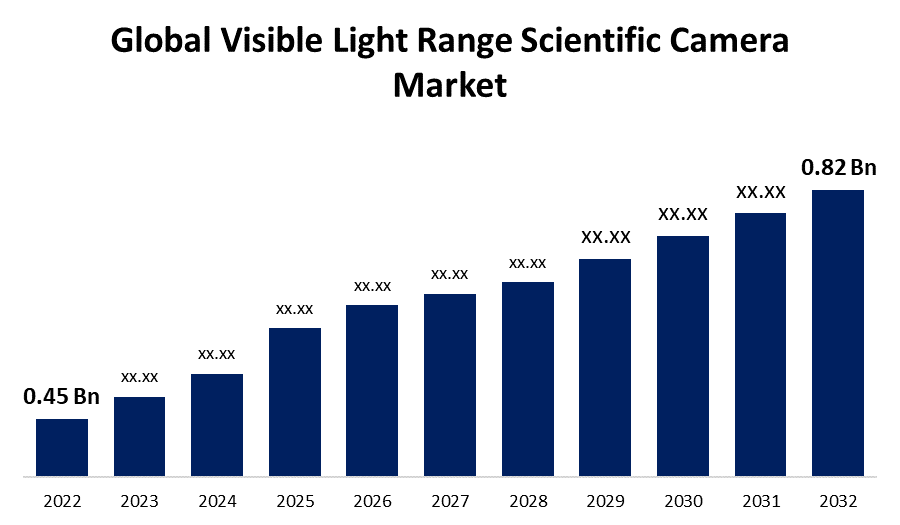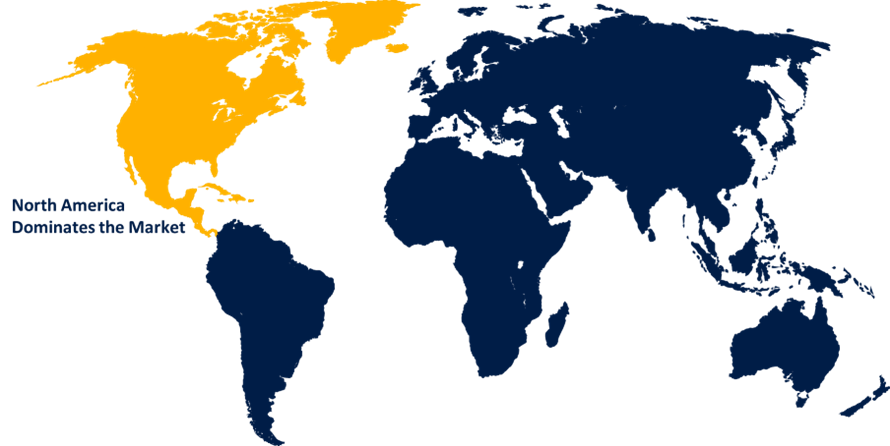Global Visible Light Range Scientific Camera Market Size, Share, and COVID-19 Impact Analysis, By Type (sCMOS, sCMOS (back-thinned), CCD, CCD (back-thinned), and EMCCD), By Camera Resolution (Below 4 MP, 4 MP to 5MP, 6 MP to 9 MP, and Above 9 MP), By Camera Price (Below USD 10,000, USD 10,000 - USD 20,000, and Above USD 20,000), By Region (North America, Europe, Asia-Pacific, Latin America, Middle East, and Africa), Analysis and Forecast 2022 – 2032
Industry: Electronics, ICT & MediaGlobal Visible Light Range Scientific Camera Market Insights Forecasts to 2032
- The Global Visible Light Range Scientific Camera Market Size was valued at USD 0.45 Billion in 2022.
- The Market Size is growing at a CAGR of 6.2% from 2022 to 2032
- The Worldwide Visible Light Range Scientific Camera Market Size is expected to reach USD 0.82 Billion by 2032
- Asia-Pacific is expected to have significant to grow during the forecast period

Get more details on this report -
The Global Visible Light Range Scientific Camera Market Size is expected to reach USD 0.82 Billion by 2032, at a CAGR of 6.2% during the forecast period 2022 to 2032.
Market Overview
A visible light range scientific camera is an advanced imaging device used in scientific research and various applications. It operates within the visible light spectrum, which ranges from approximately 400 to 700 nanometers. These cameras are designed to capture and analyze the properties of light, enabling scientists to study phenomena such as fluorescence, bioluminescence, and absorption. They employ high-quality sensors and optics to produce high-resolution images with exceptional color accuracy. Visible light range scientific cameras find applications in fields like biology, astronomy, microscopy, and spectroscopy. They are crucial tools for studying cellular structures, astronomical objects, chemical reactions, and other scientific processes that involve visible light. With their versatility and precision, these cameras contribute significantly to advancing scientific knowledge and understanding in various disciplines.
Report Coverage
This research report categorizes the market for visible light range scientific camera market based on various segments and regions and forecasts revenue growth and analyzes trends in each submarket. The report analyses the key growth drivers, opportunities, and challenges influencing the visible light range scientific camera market. Recent market developments and competitive strategies such as expansion, product launch, and development, partnership, merger, and acquisition have been included to draw the competitive landscape in the market. The report strategically identifies and profiles the key market players and analyses their core competencies in each sub-segments of the visible light range scientific camera market.
Global Visible Light Range Scientific Camera Market Report Coverage
| Report Coverage | Details |
|---|---|
| Base Year: | 2022 |
| Market Size in 2022 : | USD 0.45 Billion |
| Forecast Period: | 2022-2032 |
| Forecast Period CAGR 2022-2032 : | 6.2% |
| 2032 Value Projection: | USD 0.82 Billion |
| Historical Data for: | 2018-2021 |
| No. of Pages: | 200 |
| Tables, Charts & Figures: | 110 |
| Segments covered: | By Type, By Camera Resolution, By Camera Price, By Region |
| Companies covered:: | Atik Cameras, Diffraction Limited, Excelitas PCO GmbH, Hamamatsu Photonics Thorlabs, Inc., Horiba Scientific, IDEX Health & Science, Meiji Techno, Photonic Science, Raptor Photonics, Spectral Instruments, Inc., Teledyne Technologies, Thorlabs, Inc., XIMEA GmbH |
| Pitfalls & Challenges: | COVID-19 Empact,Challenges, Future, Growth, & Analysis |
Get more details on this report -
Driving Factors
The visible light range scientific camera market is driven by several key factors that contribute to its growth and adoption such as the increasing demand for advanced imaging solutions in scientific research and applications is a major driver. Researchers across various fields require high-resolution, accurate imaging of visible light phenomena, and these cameras fulfill that need. Additionally, technological advancements in sensor technology, optics, and image processing algorithms have led to improved camera performance, further fueling market growth. The expanding applications of scientific cameras in fields like biology, astronomy, microscopy, and spectroscopy are also driving market demand. Furthermore, the growing focus on healthcare and life sciences research, as well as the rising investments in scientific research and development, are contributing to the market's expansion. Overall, the increasing awareness and importance of visual data in scientific analysis and the availability of cost-effective camera solutions are factors that are propelling the visible light range scientific camera market forward.
Restraining Factors
The visible light range scientific camera market faces certain restraints that can hinder its growth. The high cost associated with advanced camera systems and the need for specialized equipment may limit the adoption of these cameras, especially for small research facilities or budget-constrained projects. Additionally, the complexity of operating and integrating these cameras into existing scientific setups can pose a challenge for researchers, requiring specialized knowledge and expertise. Moreover, the presence of alternative imaging technologies, such as infrared or ultraviolet cameras, for specific applications may divert potential customers away from visible light range cameras. Overall, limitations in camera sensitivity or dynamic range, as well as potential issues with noise or artifacts in the captured images, can also restrict the widespread adoption of visible light range scientific cameras in certain research domains.
Market Segmentation
- In 2022, the below 4 MP segment accounted for around 31.5% market share
On the basis of the camera resolution, the global visible light range scientific camera market is segmented into below 4 MP, 4 MP to 5 MP, 6 MP to 9 MP, and above 9 MP. The 4 MP camera segment has emerged as the leading segment in the visible light range scientific camera market, holding the largest market share. Several factors contribute to the dominance of this segment because 4 MP resolution offers a balance between high-quality imaging and manageable data size, making it suitable for a wide range of scientific applications. Researchers can capture detailed images without overwhelming data storage and processing capabilities. Additionally, advancements in sensor technology have improved the performance and sensitivity of 4 MP cameras, enabling researchers to achieve accurate and precise results. Moreover, the affordability and availability of 4 MP cameras have made them accessible to a broader user base, including academic institutions, small research laboratories, and industrial settings. Furthermore, the versatility of 4 MP cameras allows their application in various fields, such as biology, microscopy, and materials science, driving their demand and market share.
- In 2022, the sCMOS segment dominated with more than 23.5% market share
Based on the type, the global visible light range scientific camera market is segmented into sCMOS, sCMOS (back-thinned), CCD, CCD (back-thinned), and EMCCD. The sCMOS segment has emerged as the dominant force in the visible light range scientific camera market, capturing the largest market share because of sCMOS (scientific complementary metal-oxide-semiconductor) technology offers significant advantages over traditional CCD and CMOS sensors, including high-speed imaging, low noise, and excellent sensitivity. These features make sCMOS cameras highly desirable for demanding scientific applications that require fast data acquisition and high image quality. Additionally, advancements in sCMOS sensor technology have resulted in improved performance, such as increased quantum efficiency and enhanced dynamic range. Furthermore, sCMOS cameras have found extensive applications in fields like microscopy, astronomy, biophotonics, and fluorescence imaging, further fueling their dominance in the market. The combination of superior performance, versatility, and application-specific benefits has propelled the sCMOS segment to the forefront of the visible light range scientific camera market.
Regional Segment Analysis of the Visible Light Range Scientific Camera Market
- North America (U.S., Canada, Mexico)
- Europe (Germany, France, U.K., Italy, Spain, Rest of Europe)
- Asia-Pacific (China, Japan, India, Rest of APAC)
- South America (Brazil and the Rest of South America)
- The Middle East and Africa (UAE, South Africa, Rest of MEA)
North America dominated the market with more than 36.2% revenue share in 2022.

Get more details on this report -
North America has established itself as the dominant region in the visible light range scientific camera market, holding the largest market share. Several factors contribute to this significant market presence. North America boasts a robust scientific research ecosystem, with renowned universities, research institutions, and pharmaceutical companies driving the demand for advanced imaging solutions. Additionally, the region has a well-established infrastructure for technological innovation and development, attracting major camera manufacturers and fostering a competitive market landscape. Furthermore, the presence of a highly skilled workforce, coupled with significant investments in research and development, enables North America to stay at the forefront of scientific advancements. Moreover, the region's strong healthcare sector and ongoing technological advancements in fields like biotechnology, life sciences, and aerospace further contribute to the demand for visible light range scientific cameras. These factors collectively contribute to North America's leading position in the market.
Competitive Analysis:
The report offers the appropriate analysis of the key organizations/companies involved within the global visible light range scientific camera market along with a comparative evaluation primarily based on their product offering, business overviews, geographic presence, enterprise strategies, segment market share, and SWOT analysis. The report also provides an elaborative analysis focusing on the current news and developments of the companies, which includes product development, innovations, joint ventures, partnerships, mergers & acquisitions, strategic alliances, and others. This allows for the evaluation of the overall competition within the market.
List of Companies:
- Atik Cameras
- Diffraction Limited
- Excelitas PCO GmbH
- Hamamatsu Photonics Thorlabs, Inc.
- Horiba Scientific
- IDEX Health & Science
- Meiji Techno
- Photonic Science
- Raptor Photonics
- Spectral Instruments, Inc.
- Teledyne Technologies
- Thorlabs, Inc.
- XIMEA GmbH
Key Target Audience
- Market Players
- Investors
- End-Users
- Government Authorities
- Consulting and Research Firm
- Venture Capitalists
- Value-Added Resellers (VARs)
Recent Developments
- In June 2021, The HAWKeye sCMOS camera 4123, introduced by Photonic Science, incorporates the sCMOS Fairchild 4123 sensor, which possesses a readout noise of 0.5 electrons, a minimal number of defective pixels, and a low level of dark current.
Market Segment
This study forecasts revenue at global, regional, and country levels from 2019 to 2032. Spherical Insights has segmented the global visible light range scientific camera market based on the below-mentioned segments:
Visible Light Range Scientific Camera Market, By Type
- sCMOS
- sCMOS (back-thinned)
- CCD
- CCD (back-thinned)
- EMCCD
Visible Light Range Scientific Camera Market, By Camera Resolution
- Below 4 MP
- 4 MP to 5MP
- 6 MP to 9 MP
- Above 9 MP
Visible Light Range Scientific Camera Market, By Camera Price
- Below USD 10,000
- USD 10,000 - USD 20,000
- Above USD 20,000
Visible Light Range Scientific Camera Market, Regional Analysis
- North America
- US
- Canada
- Mexico
- Europe
- Germany
- UK
- France
- Italy
- Spain
- Russia
- Rest of Europe
- Asia Pacific
- China
- Japan
- India
- South Korea
- Australia
- Rest of Asia Pacific
- South America
- Brazil
- Argentina
- Rest of South America
- Middle East & Africa
- UAE
- Saudi Arabia
- Qatar
- South Africa
- Rest of Middle East & Africa
Need help to buy this report?